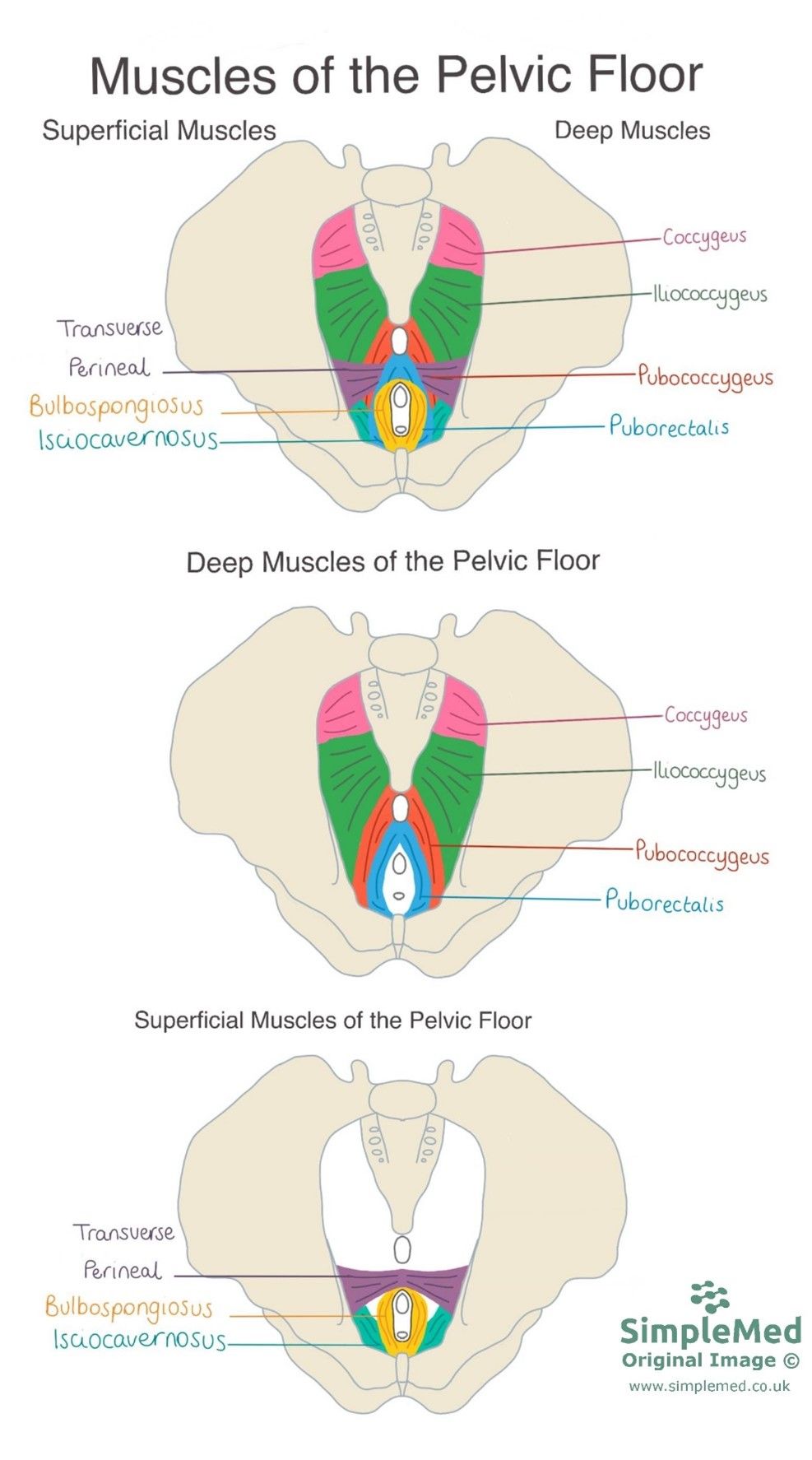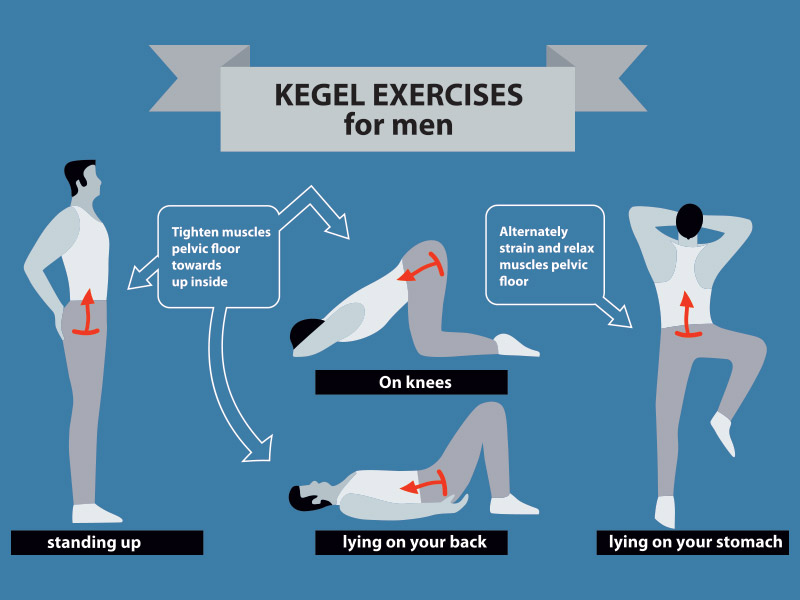Imagine this: You’re laughing with friends, and suddenly, a little “oops” happens. Or, you’re lifting a heavy box, and you feel a strange pressure in your lower abdomen. These experiences, while potentially embarrassing, can be a sign of a weakness in your pelvic floor muscles. But don’t worry, it’s not a hopeless situation.

Image: simplemed.co.uk
The pelvic floor is a group of muscles that act like a sling, supporting your bladder, bowels, and uterus (for women). When these muscles are strong, they help you control bladder and bowel function, prevent incontinence, and even enhance your sex life. But just like any other muscle group, they need to be exercised to stay strong. In this comprehensive guide, we’ll delve into the world of pelvic floor exercises, equipping you with the knowledge and techniques to strengthen your pelvic floor and reclaim control over your body.
Understanding Your Pelvic Floor: The Foundation of Support
The pelvic floor is more than just a group of muscles – it’s a vital part of your body’s intricate network. Think of it as the base of your core, a bridge connecting your lower body to your upper body. These muscles play a crucial role in a multitude of bodily functions:
-
Bladder and Bowel Control: Strong pelvic floor muscles help you hold your bladder and bowels, preventing accidents and promoting continence.
-
Sexual Function: These muscles contribute to sexual pleasure and arousal.
-
Pregnancy and Childbirth: For women, strong pelvic floor muscles are essential during pregnancy to support the growing uterus and during childbirth to aid in delivery and recovery.
-
Posture: A strong pelvic floor helps maintain good posture and alignment, reducing back pain and promoting stability.
-
Organs and Internal Support: Providing a base of support for your pelvic organs, strengthening these muscles is crucial for preventing organ prolapse.
The Benefits of Pelvic Floor Exercises
Working out your pelvic floor muscles offers a range of benefits that can impact your overall health and well-being:
-
Improved Bladder and Bowel Control: You’ll likely experience a significant reduction in leaks and accidents, giving you the confidence to laugh, sneeze, or exercise without fear.
-
Enhanced Sexual Function: Increased sensation and control can lead to a more fulfilling and pleasurable sex life.
-
Reduced Risk of Prolapse: Strengthening these muscles can help prevent organs from dropping or falling out of place.
-
Improved Posture: It can lead to better alignment and reduced back pain, allowing you to stand and move with more ease.
-
Boost to Confidence: Feeling secure and in control of your body can significantly impact your self-esteem and overall confidence.
Mastering the Art of Pelvic Floor Exercise: Unveiling the Techniques
The good news is that anyone can strengthen their pelvic floor muscles. You don’t need fancy equipment or a gym membership. These exercises can be done anywhere and anytime. Here’s a breakdown of the most effective techniques:

Image: andreaspartydesigns.blogspot.com
1. The Kegel: The Foundation of Pelvic Floor Training
Named after Dr. Arnold Kegel, this simple exercise is the cornerstone of pelvic floor strengthening:
-
Identify Your Muscles: Imagine you’re trying to stop the flow of urine mid-stream—that’s the sensation you’re looking for. You’ll be contracting the pelvic floor muscles, but only these muscles. Avoid squeezing other muscles like your buttocks or abdomen.
-
Execute the Squeeze: Gently contract your pelvic floor muscles as if you’re lifting them up and inwards. Hold the contraction for 3-5 seconds, then slowly relax.
-
Practice, Practice, Practice: Aim for 3 sets of 10 repetitions daily. You can work up to holding contractions for longer periods and increasing the number of reps as you get stronger.
2. The Bridge: A Full-Body Approach
This exercise engages your entire core, including the pelvic floor, and adds strength to your glutes and hamstrings:
-
Get into Position: Lie on your back with your knees bent and your feet flat on the floor.
-
Engage Your Core: As you did with the Kegel, make sure you’re engaging your pelvic floor muscles.
-
Lift Your Hips: Slowly lift your hips off the ground, pushing through your heels, until your body forms a straight line from your shoulders to your knees.
-
Lower Slowly: Lower your hips back down to the starting position.
-
Repeat: Perform 10-15 repetitions for 3 sets.
3. The Squat: Strengthening and Stability
This exercise works wonders for your pelvic floor, in addition to your thighs, glutes, and core:
-
Proper Form: Stand with your feet hip-width apart and your toes slightly pointed outwards. Engage your pelvic floor muscles.
-
Descend Slowly: Bend your knees and lower your hips as if you’re sitting down on a chair. Keep your back straight and your core engaged.
-
Return to Standing: Push through your heels to return to a standing position.
-
Reps: Aim for 10-15 repetitions for 3 sets.
4. The Plank: The Ultimate Core Challenge
This exercise engages your entire core, including the pelvic floor, and targets your shoulders and arms:
-
Get into Position: Start in a push-up position, with your forearms flat on the floor, shoulder-width apart, and your body in a straight line from head to heels.
-
Engage Your Core: Ensure you are engaging your pelvic floor muscles.
-
Hold It: Hold this position for as long as you can, maintaining proper form.
-
Progress Gradually: As you get stronger, aim to increase the duration of your holds.
5. Mindful Breathing: Connecting with Your Pelvic Floor
Taking mindful breaths can be a powerful tool in strengthening your pelvic floor:
-
Inhale Deeply: Inhale deeply, expanding your abdomen.
-
Exhale Slowly: As you exhale, gently contract your pelvic floor muscles, drawing them upward.
-
Repeat: Continue this gentle contraction and release with each breath.
Integrating Pelvic Floor Exercises into Your Daily Routine
The key to strengthening your pelvic floor muscles is consistency. Try to incorporate these exercises into your daily routine. Here are some ideas:
-
While Commuting: Do Kegels while sitting in your car or on a bus.
-
During Work Breaks: Perform a few reps of pelvic floor exercises while sitting at your desk during brief breaks.
-
While Watching TV: Relax and practice your Kegels during commercials.
-
In the Shower: Engage your pelvic floor muscles during your morning or evening shower.
-
Before Bed: Make it a habit to complete a few sets of pelvic floor exercises before you turn in for the night.
Expert Insights: Unlocking the Secrets of Pelvic Floor Strength
We spoke with Dr. Mary Smith, a renowned pelvic floor specialist, for her professional insights:
“It’s crucial to be aware of your body and its signals. If you notice any changes in your bladder or bowel function, seek guidance from a healthcare professional. They can assess your condition and recommend the best treatment plan, which might include specialized exercises or other therapies. Additionally, healthy habits like maintaining a healthy weight, avoiding smoking, and lifting properly can further support the strength of your pelvic floor.”
How To Work Out Pelvic Floor Muscles
Your Pelvic Floor: A Journey to Strength and Well-being
Strengthening your pelvic floor muscles is an empowering journey that can have a lasting impact on your life. By practicing these exercises regularly, you’ll experience improved bladder and bowel control, enhanced sexual function, and a greater sense of confidence. Remember, consistency is key. Even small changes can make a big difference. So, take charge of your health, embrace your pelvic floor, and enjoy the benefits of a strong and resilient body.






